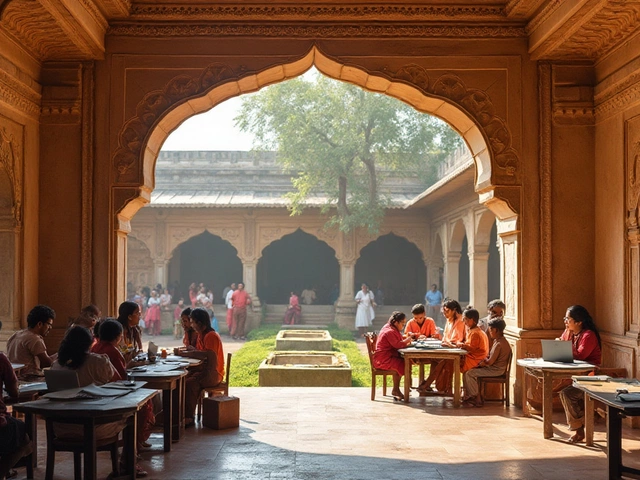
The first thing people ask when a girl says she wants to become a doctor is, "Which branch are you planning to pick?" It’s a classic question, especially among NEET aspirants. There’s this idea that some specializations suit girls more, and honestly, it’s not just an old myth—it’s shaped by real factors. Some branches offer more flexible hours, others are less physically demanding, and some have way more women, so the work environment feels friendlier.
But here’s the thing: medicine isn’t meant to be one-size-fits-all. What’s best depends a lot on personal strengths, lifestyle goals, and what you actually enjoy doing every day. For example, pediatrics and obstetrics & gynecology are top favorites—not just in India but globally—because they combine a strong sense of purpose with a balanced routine. On the other hand, there’s a growing number of women choosing to break into male-dominated fields like surgery and orthopedics. Sometimes it’s about challenging stereotypes, but often it’s just about following what feels right.
If you’re prepping for NEET and thinking about your options, it’s smart to start checking out the realities of each branch. Chat with seniors during hospital internships or ask questions in coaching seminars—they’ll give you the straight talk you won’t find in textbooks. Keep in mind, there’s no unwritten rule about what girls should or shouldn’t pick. The best field is the one you see yourself sticking with, even on those tough, stressful days.
- Why This Question Comes Up
- Popular Medical Specialties for Girls
- Tips for Choosing the Right Medical Field
- Advice from Female Doctors: What Matters Most
Why This Question Comes Up
It surprises a lot of students, but thinking about the best doctor for girls isn’t just about skills or marks. Families and even teachers bring up this question for practical and cultural reasons. Some medical fields are seen as 'easier' on family life, while others are considered more demanding or have long, unpredictable hours. For many parents, job safety, stability, and 'settling down' are top concerns, so certain specializations get pushed more than others.
There’s also a social angle no one talks about openly—things like safety, night shifts, patient handling, and even the gender mix of each branch. In some government colleges, the number of girls in certain specialties like Orthopedics or Cardiology is way lower compared to Pediatrics or Obstetrics & Gynecology. A quick glance across top medical colleges backs this up.
| Specialization | % Female PG Students (2024, India) |
|---|---|
| Pediatrics | 72% |
| Obstetrics & Gynecology | 93% |
| General Surgery | 18% |
| Orthopedics | 6% |
Even hospital work patterns matter. For example, some branches have less night duties or involve less emergency work, which makes them more appealing for girls who prefer fixed schedules. A lot of girls feel more comfortable where they see other women as seniors, so the gender ratio in a branch ends up influencing decisions a lot more than you’d think.
But times are changing, with more girls cracking NEET and choosing paths that wouldn’t have even been suggested to them ten years ago. What’s making this question pop up more often now is a mix of tradition, current trends, and the changing face of the Indian medical system.
Popular Medical Specialties for Girls
If you ask around in any NEET coaching class, you’ll hear certain specialties pop up a lot when it comes to girls choosing their path. This isn’t just a trend in India—global surveys have found similar patterns. It comes down to things like better work-life balance, lower emergency calls, and patient groups that girls often connect with well.
Here’s a quick look at the medical fields most girls prefer after NEET:
- Pediatrics: Kids usually mean less physical strain, and it’s rewarding to see young patients recover. In India, over 60% of pediatric postgrad seats recently went to women. Hospitals also report that parents prefer female pediatricians for young children.
- Obstetrics and Gynaecology: No surprise here. Girls dominate this specialty—nearly 80% of gynecology PG students in India are women. Many patients look for female doctors for privacy and comfort.
- Dermatology: This one is famous for a good lifestyle. There are regular hours, barely any night shifts, and it’s less stressful. Plus, skin care is a booming field with lots of private practice opportunities.
- Psychiatry: More women are choosing psychiatry for its steady hours and meaningful patient impact. In the last five years, the percentage of female psychiatrists in India has doubled according to medical council reports.
- Pathology and Radiology: If you want less direct patient drama but love analysis, these are solid picks. Lab-based and imaging roles mean regular schedules, and around half the seats in these PG branches go to girls now.
“Young female doctors tell me they choose these branches because they want a balance between family life and a medical career. But that doesn’t mean they can’t shine in other fields too!” — Dr. Vandana Aggarwal, Head of Pediatrics at a top Delhi hospital
To really see how it plays out, check out this simple table showing current trends from the National Board of Examinations (Feb 2025):
| Specialty | % Female PG Students (2024) | Key Advantage |
|---|---|---|
| Pediatrics | 62% | Flexible hours, rewarding |
| Obstetrics & Gynecology | 78% | High demand, patient preference |
| Dermatology | 55% | Good lifestyle, low stress |
| Psychiatry | 48% | Predictable hours, mental health focus |
| Pathology/Radiology | 50% | Lab-based, fewer emergencies |
Of course, these numbers don’t mean you have to follow the crowd. Plenty of girls become top-notch surgeons, cardiologists, or orthopedists. But if you’re looking for a specialty with solid support, proven demand, and a smoother work-life setup, these are the front runners—especially for anyone asking about the best doctor for girls path right after NEET.

Tips for Choosing the Right Medical Field
Picking your medical specialty isn’t about what’s trending on social media or what your relatives tell you. It’s about finding the right fit for your strengths, your dreams, and your lifestyle. Here’s how you can make a smarter choice:
- Research How the Day-to-Day Looks: Actually talk to doctors working in different fields. Ask them about their daily routine. Some jobs, like general surgery, demand early mornings and late nights. Dermatology and radiology, on the other hand, often have more predictable hours and less emergency calls. If work-life balance matters to you, factor this in.
- Know the Competition Level: Some branches fill up fast at NEET counseling, especially best doctor for girls specialties like pediatrics and OBGYN. Check last year’s NEET cutoff ranks to see where your score fits. High-demand fields mean tougher competition.
- Consider Long-Term Growth: Look at statistics – according to NMC data (2024), over 50% of women doctors in India pick OBGYN, Pediatrics, or Dermatology. But fields like Psychiatry and ENT are catching up because they offer solid career growth and flexibility.
- Think About Physical and Emotional Demands: Some branches, like Orthopedics, require more physical stamina. Others like Psychiatry involve emotional intelligence over brute force. Know your comfort zone, but don’t be afraid to push your limits if you feel drawn to a certain area.
- Check Gender Ratios in the Specialty: If a supportive peer group matters, check real numbers. Here’s a quick look at gender splits from recent data:
| Specialty | Female Doctors (%) | Average Work Hours / Week |
|---|---|---|
| Obstetrics & Gynecology | 68 | 48 |
| Pediatrics | 61 | 45 |
| Dermatology | 56 | 40 |
| Surgery | 19 | 55 |
| Psychiatry | 43 | 38 |
Don’t forget that stats are just a starting point. Plenty of women succeed in fields where they’re outnumbered. But it helps to know what you’re stepping into.
Finally, test your interest early. Volunteer at hospitals, shadow different doctors, or join career sessions at your NEET coaching center. Real-world exposure always beats guessing. The right medical field for you is the one where you can picture yourself doing challenging but fulfilling work every single day, not just one that someone labels as "best for girls."
Advice from Female Doctors: What Matters Most
When you ask women already working in medicine what really counts, you get practical answers, not vague pep talks. A ton of female doctors in India and worldwide say the same thing: focus on what fits your priorities, not just what sounds safe or traditional for girls. They talk about real-life stuff like work hours, support from mentors, exposure to different types of patients, and how your career will change as you get older.
“Choosing a specialty is personal. I picked pediatrics because I knew I wanted both a family life and a job that makes me excited to get up every day,” says Dr. Aishwarya Sharma, a consultant pediatrician at AIIMS Delhi, who also mentors NEET aspirants online.
One thing you keep hearing is, don’t get boxed in by others’ ideas of the best doctor for girls. Some go for gynecology or dermatology because they’re seen as ‘girl-friendly’, but others jump into orthopedics or emergency medicine because that’s where their passion is. The tide is definitely turning—almost 47% of India’s MBBS seats went to women in 2023, and more are signing up for postgrad residencies in all specialties. Here’s a snapshot of the postgraduate scene in India:
| Specialty | Approx. % of Female Residents (2023) |
|---|---|
| Pediatrics | 64% |
| Obstetrics & Gynecology | 82% |
| Dermatology | 58% |
| General Surgery | 26% |
| Orthopedics | 13% |
Female doctors also zero in on these practical factors when picking a field:
- Scheduling matters: If family time or flexibility is big for you, look for branches with more control over your shifts (like dermatology or pathology).
- Support system: Reach out to women already in your target field—most are happy to share honest advice or even let you shadow them for a day.
- Income and growth: Think about earning potential, but remember, satisfaction and burnout rates are just as crucial. According to an IMA survey, female surgeons report higher job stress, but also high job pride if they're passionate about the field.
- Long-term fit: Medicine is lifelong learning. Choose a branch you can imagine doing even after ten or twenty years; your interests can and will evolve.
If you take anything from women further along this road, it’s this—pick a specialty based on what excites you and what lifestyle you actually want. Don’t worry about being the only girl in a room if that’s where you want to be. Today, more doors are open than ever if you're willing to walk through them.
More Articles

Top Destinations for International Study in 2025
Choosing the best country for studying abroad can be a thrilling yet challenging decision for students. This article explores some of the top countries known for their robust education systems, cultural diversity, and unique student experiences. Factors like cost of living, language, and post-study opportunities are also discussed, helping students to make an informed choice. Whether you're drawn to the historic campuses of Europe or the innovative universities in Asia, there's a perfect fit for everyone.

Understanding Teacher Training Schools: What They Are Also Called
Teacher training schools, often referred to as normal schools or teacher colleges, are institutions dedicated to educating aspiring teachers on the art and science of teaching. These schools focus on equipping students with both theoretical knowledge and practical skills necessary for effective classroom instruction. The history of teacher training schools dates back centuries and has evolved extensively over time. Such institutions play a pivotal role in preparing educators to meet the diverse needs of modern learners. In this article, we delve into various names for teacher training schools, their significance, and the educational pathways they offer.

Can I Learn Coding on My Own?
Learning to code on your own is more than possible with the right resources and mindset. Plenty of free and paid online resources give you the flexibility to learn at your own pace. Enthusiasm and consistency are key to overcoming the challenges of self-study. Discover practical tips, common obstacles, and real-world examples of successful self-taught programmers.
